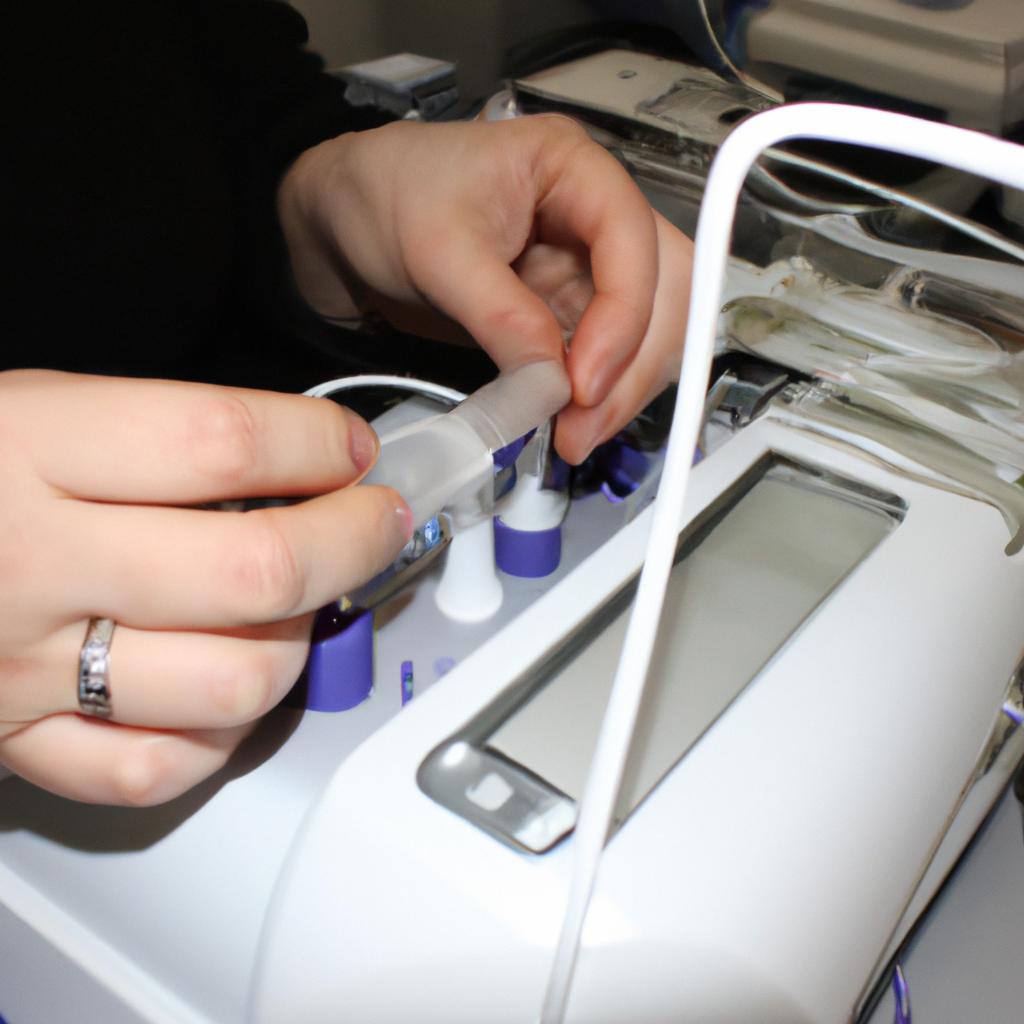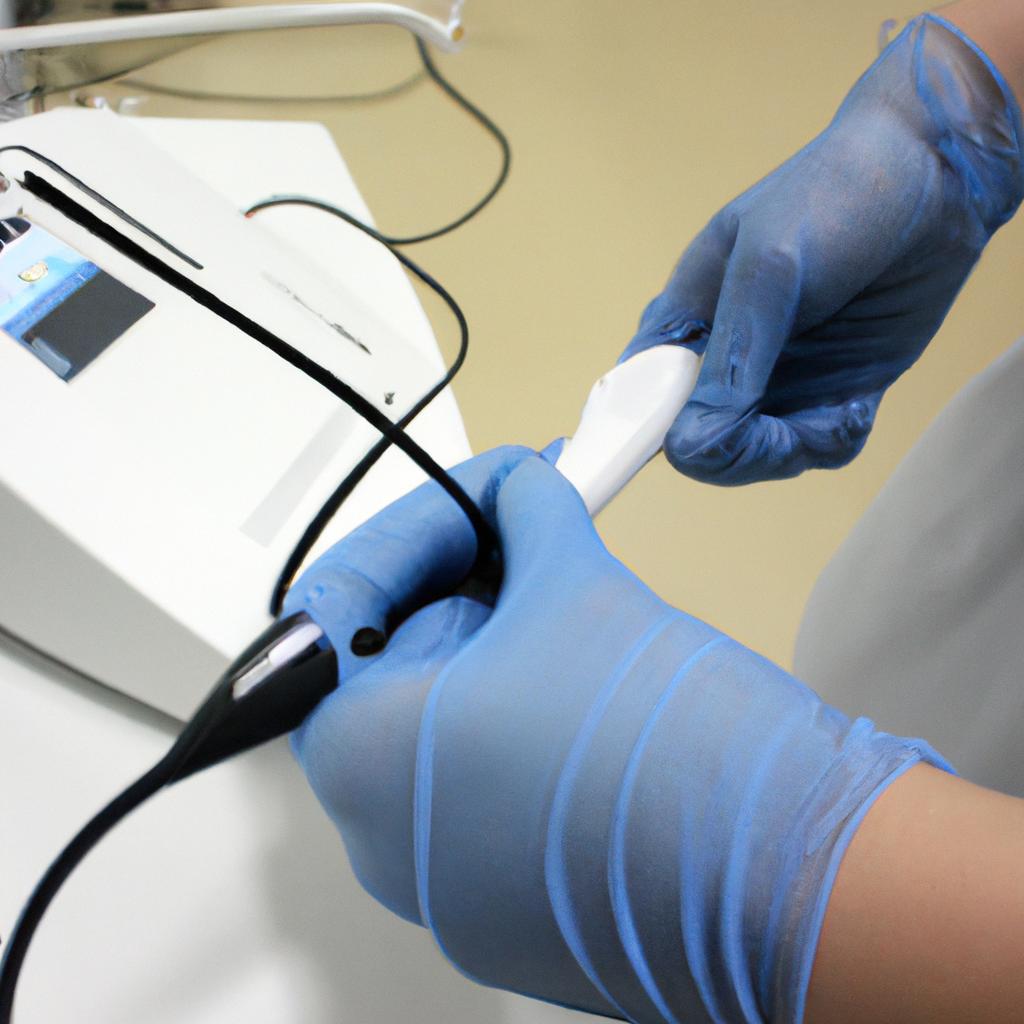In the field of engineering, particularly in the design and development of medical devices, adherence to regulatory requirements is paramount. These regulations serve as guidelines to ensure that medical devices are safe, effective, and reliable for use by patients. Failure to comply with these requirements can have serious consequences not only for manufacturers but also for healthcare providers and most importantly, the end-users – patients themselves.
One example that highlights the importance of regulatory requirements in medical device design is the case of a faulty implantable cardiac defibrillator (ICD) that was recalled due to malfunctions. This particular device had undergone rigorous testing during its development phase; however, it failed to meet certain regulatory standards once released into the market. Consequently, numerous patients experienced adverse events such as unnecessary shocks or even failure of life-saving therapy. This incident underscores the critical role played by regulatory authorities in ensuring patient safety through stringent evaluation processes and continuous monitoring throughout a product’s lifecycle.
Within this context, this article aims to provide insights into the various regulatory requirements that engineers must consider when designing medical devices. By exploring key aspects such as quality management systems, risk assessment methodologies, usability evaluations, and post-market surveillance obligations, this article seeks to enhance understanding among engineering professionals regarding their responsibilities in meeting these mandatory guidelines.
Overview of Regulatory Landscape
The field of engineering, particularly in the design and development of medical devices, is subject to a complex regulatory landscape. These regulations aim to ensure the safety, efficacy, and quality of medical devices before they can be introduced into the market. To illustrate this point, let us consider a hypothetical scenario where an innovative implantable cardiac device has been developed. Before it can reach patients in need, various regulatory requirements must be met.
Firstly, one key aspect of the regulatory landscape involves obtaining approval from regulatory bodies such as the Food and Drug Administration (FDA) in the United States or the European Medicines Agency (EMA) in Europe. These agencies evaluate not only the technical aspects but also conduct rigorous assessments regarding clinical performance and safety considerations associated with using new medical devices. Compliance with these standards ensures that potential risks are minimized while maximizing patient benefits.
Secondly, manufacturers must adhere to international standards specific to medical device design and production processes. Standards like ISO 13485 outline guidelines for quality management systems within organizations involved in healthcare product manufacturing. Such adherence enables companies to demonstrate their commitment towards maintaining high-quality products throughout the entire lifecycle – from concept development through post-market surveillance.
Furthermore, another significant component of the regulatory landscape pertains to documentation and record-keeping practices during every stage of product development. Detailed records provide evidence that proper procedures were followed and enable accountability if any issues arise later on. From design specifications to risk management files and clinical trial data, comprehensive documentation allows regulators to verify compliance with all relevant regulations.
In summary, navigating the regulatory landscape in medical device engineering requires careful attention to detail at each step along the way. By understanding and meeting these requirements effectively, engineers can contribute to ensuring patient safety and ultimately improve healthcare outcomes.
Transitioning into our next section about “Key Regulatory Bodies,” it is essential to explore how different agencies play pivotal roles in setting guidelines for safe medical device designs and approvals without compromising innovation.
Key Regulatory Bodies
Regulatory Bodies in Engineering: Ensuring Compliance
To illustrate the importance of regulatory bodies in engineering, let us consider a hypothetical case study involving the development of a new medical device. Imagine that a team of engineers is working on designing an innovative glucose monitoring system for diabetic patients. The successful implementation and safe use of this device rely heavily on adherence to regulatory requirements set forth by various governing bodies.
In order to meet these regulations, engineers must navigate through a complex landscape of standards and guidelines established by different entities. Key regulatory bodies play a crucial role in ensuring compliance with safety measures and quality assurance protocols throughout the entire design process. These bodies include organizations such as the Food and Drug Administration (FDA) in the United States, the European Medicines Agency (EMA), Health Canada, and other regional or national authorities.
Complying with regulatory requirements involves several essential steps:
- Conducting thorough risk assessments to identify potential hazards associated with the device
- Implementing effective quality management systems to ensure consistency and traceability
- Establishing rigorous testing procedures to validate product performance and safety
- Maintaining comprehensive documentation to demonstrate compliance with applicable regulations
The significance of adhering to these requirements cannot be overstated. Failure to comply can result in serious consequences, including legal ramifications, financial penalties, damage to reputation, and most importantly, compromising patient safety.
| Regulatory Body | Region/Country | Role/Responsibility |
|---|---|---|
| FDA | United States | Reviews and approves medical devices before market release |
| EMA | Europe | Evaluates medicinal products for human use within EU |
| Health Canada | Canada | Regulates health products for Canadians |
| MHRA | United Kingdom | Oversees medicines and healthcare products |
As we have seen, understanding and complying with regulatory requirements is vital when it comes to engineering any medical device. By establishing effective design control processes and maintaining meticulous documentation, engineers can ensure that their products meet all necessary standards and regulations without compromising quality or safety.
Transition: With an understanding of the key regulatory bodies in place, let us now explore how design control and documentation contribute to ensuring compliance throughout the medical device development process.
Design Control and Documentation
To illustrate the importance of design control and documentation in regulatory requirements for medical device design, let’s consider a hypothetical case study. Imagine a team of engineers developing a new implantable cardiac pacemaker. They must navigate through various stages of product development, ensuring that every step is meticulously documented to meet regulatory standards.
Design control plays a crucial role in this process. It involves establishing procedures to manage the entire lifecycle of the medical device, from initial concept to post-market surveillance. A comprehensive design control plan enables systematic identification, traceability, and verification of each element involved in the device’s development. This promotes consistency, reliability, and safety throughout the design process.
Documentation serves as an essential aspect of design control. By maintaining accurate records at every stage, engineers can demonstrate compliance with regulatory bodies’ requirements effectively. These documents include specifications, risk analyses, testing protocols, validation reports, and change management logs. Thorough documentation not only ensures transparency but also facilitates communication between multidisciplinary teams working on different aspects of the project.
Emphasizing the significance of design control and documentation further, here are key points to consider:
- Clear and concise documentation assists in identifying potential hazards during all phases of device development.
- Accurate record-keeping aids in demonstrating conformity with applicable regulations.
- Robust design controls minimize risks associated with inadequate or faulty designs.
- Comprehensive documentation allows for efficient knowledge transfer within organizations.
Additionally, we can visualize these concepts using a table:
| Key Points |
|---|
| Clear and concise documentation |
| Compliance demonstration |
| Risk mitigation through robust design controls |
| Efficient knowledge transfer |
In summary, effective design control and meticulous documentation are fundamental elements in meeting regulatory requirements for medical device design. Engineers must adhere to established processes while maintaining detailed records to ensure their devices fulfill safety standards set by relevant regulatory bodies.
Transitioning into our next section about “Risk Management in Medical Device Design,” let’s explore how engineers address potential risks associated with the design and development of medical devices.
Risk Management in Medical Device Design
In the field of medical device design, risk management is a crucial aspect that ensures the safety and effectiveness of these devices. By identifying potential risks early on in the design process, engineers can implement appropriate measures to mitigate those risks and improve patient outcomes.
To illustrate the importance of risk management, let’s consider a hypothetical case study involving the development of an implantable cardiac pacemaker. During the initial stages of design, engineers identified several potential risks associated with this device, including infection at the implant site, malfunctioning leads, battery failure, and electromagnetic interference. These risks were then assessed for severity and probability to prioritize mitigation strategies.
To effectively manage risks in medical device design, engineers must follow certain guidelines:
- Conduct a thorough risk assessment: This involves systematically identifying potential hazards, assessing their likelihood and severity, and prioritizing them based on their impact on patient safety.
- Implement risk controls: Once risks have been identified and assessed, engineers must develop strategies to reduce or eliminate those risks. This may involve modifying designs, incorporating fail-safe mechanisms, or enhancing manufacturing processes.
- Document all decisions: It is essential to maintain detailed documentation throughout the risk management process. This includes recording risk assessments, control measures implemented, and any changes made to address identified risks.
- Continuously monitor and review: Risk management should not be a one-time activity but rather an ongoing process. Regular monitoring allows for timely identification of new risks or modifications needed due to changing regulations or technological advancements.
| Risk | Likelihood | Severity | Control Measure |
|---|---|---|---|
| Infection at implant site | High | Moderate | Sterilization protocols during manufacturing; use of biocompatible materials |
| Malfunctioning leads | Medium | High | Rigorous testing procedures; redundancy in lead connections |
| Battery failure | Low | High | Periodic battery life checks; warning system for low battery voltage |
| Electromagnetic interference | Medium | Moderate | Shielding and grounding techniques; compliance with electromagnetic compatibility standards |
By incorporating risk management practices into the medical device design process, engineers can ensure that potential risks are identified, assessed, and effectively controlled. This not only enhances patient safety but also helps to streamline regulatory approvals by demonstrating a proactive approach in addressing potential hazards.
Moving forward from risk management in medical device design, it is essential for engineers to establish robust quality management systems to further enhance the safety and reliability of these devices.
Quality Management Systems
Having addressed the crucial aspect of risk management in medical device design, it is imperative to delve into another essential component of engineering regulatory requirements – quality management systems. By establishing effective quality management systems, manufacturers can ensure that their medical devices meet the necessary standards and regulations. This section will explore key insights into implementing robust quality management systems within the context of medical device design.
To exemplify the significance of a well-implemented quality management system, consider a hypothetical scenario involving the development of an implantable cardiac pacemaker. In this case, adherence to stringent quality control measures throughout all stages of product development and manufacturing is paramount for ensuring patient safety and efficacy. A comprehensive approach to quality management would encompass various key aspects, including but not limited to:
- Document Control: Implementing rigorous document control procedures ensures that all relevant documentation, such as design specifications, test protocols, and manufacturing instructions, are accurately maintained and readily accessible.
- Process Validation: Conducting thorough process validation activities guarantees that manufacturing processes consistently produce devices that meet predefined specifications and performance criteria.
- Supplier Management: Establishing robust supplier qualification processes enables manufacturers to select reliable suppliers who adhere to appropriate quality standards for raw materials or components used in device production.
- Corrective Action/Preventive Action (CAPA): Implementing an efficient CAPA system allows for prompt identification and resolution of any non-conformities or deviations encountered during product realization, thereby mitigating potential risks.
In addition to these critical elements, it is essential for companies involved in medical device design to cultivate a culture of continuous improvement within their organizations. By embracing ongoing evaluation and optimization endeavors, they can enhance their overall quality management systems further.
Table: Key Elements of Robust Quality Management Systems
| Key Elements | Description |
|---|---|
| Document Control | Accurate maintenance and control of all relevant documentation |
| Process Validation | Ensuring manufacturing processes consistently produce devices meeting specifications |
| Supplier Management | Qualification of reliable suppliers adhering to appropriate quality standards |
| Corrective Action/Preventive Action | Prompt identification and resolution of non-conformities or deviations during production |
Implementing a robust quality management system not only ensures compliance with regulatory requirements but also enhances patient safety, product reliability, and overall customer satisfaction. In the subsequent section, we will explore post-market surveillance and reporting as another critical aspect in medical device design.
Post-Market Surveillance and Reporting
With an effective quality management system in place, manufacturers can confidently proceed to monitor the performance and safety of their medical devices after they have been commercially launched. This ongoing evaluation through post-market surveillance allows for timely detection of any potential issues that may arise once the devices are being used by patients. By promptly addressing these concerns, manufacturers can demonstrate their commitment to patient welfare while complying with regulatory obligations surrounding adverse event reporting.
Post-Market Surveillance and Reporting
Transitioning from the previous section on quality management systems, it is important to delve into the subsequent phase of medical device design: post-market surveillance and reporting. This crucial aspect ensures that any potential issues or risks associated with a medical device are identified, monitored, and reported in a timely manner. To illustrate its significance, let us consider a hypothetical scenario involving an implantable cardiac pacemaker.
Post-market surveillance involves ongoing monitoring of devices once they have been approved for commercial distribution. In the case of our hypothetical pacemaker, this would entail collecting data on patient outcomes and experiences after implantation. By closely analyzing this information, manufacturers can identify any emerging trends or anomalies that may require further investigation. For instance, if an unusually high number of patients experience complications such as lead fractures or battery depletion, it could indicate a potential design flaw or manufacturing issue that needs immediate attention.
To ensure effective post-market surveillance and reporting processes, several key elements must be considered:
- Vigilance Systems: Establishing robust vigilance systems enables prompt identification of adverse events associated with medical devices. These systems should include mechanisms for healthcare professionals and patients to report incidents or concerns related to device performance.
- Risk Assessment: Conducting comprehensive risk assessments allows manufacturers to categorize potential hazards associated with their devices and prioritize them accordingly. This helps allocate resources efficiently by focusing efforts on mitigating higher-risk factors first.
- Incident Investigation: Promptly investigating any incidents or complaints regarding device performance is essential for understanding root causes and implementing corrective actions where necessary. Thorough investigations contribute to identifying recurring issues and preventing future occurrences.
- Regulatory Reporting: Compliance with regulatory requirements for reporting adverse events plays a vital role in ensuring transparency within the industry and safeguarding patient safety.
- Increased patient safety through proactive monitoring
- Enhanced trust between manufacturers, healthcare providers, and patients
- Timely identification and resolution of device-related issues
- Improved overall quality of medical devices
Table: Risk Assessment Matrix
| Likelihood (Probability) | Severity | |
|---|---|---|
| High | High | Critical |
| Medium | Moderate | Serious |
| Low | Low | Minor |
In conclusion, post-market surveillance and reporting are integral aspects of the regulatory requirements in engineering for medical device design. By implementing robust systems to monitor device performance and promptly report any adverse events, manufacturers can ensure patient safety while also improving the overall quality of their products. Through effective risk assessment, incident investigation, and compliance with regulatory obligations, stakeholders within the industry contribute to a safer and more reliable healthcare system.




